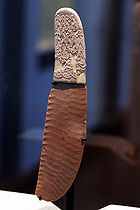
Gebel el-Arak Knife
Encyclopedia

Predynastic Egypt
The Prehistory of Egypt spans the period of earliest human settlement to the beginning of the Early Dynastic Period of Egypt in ca. 3100 BC, starting with King Menes/Narmer....
, which when it was purchased in Cairo
Cairo
Cairo , is the capital of Egypt and the largest city in the Arab world and Africa, and the 16th largest metropolitan area in the world. Nicknamed "The City of a Thousand Minarets" for its preponderance of Islamic architecture, Cairo has long been a centre of the region's political and cultural life...
was said to have been found at the site of Gebel el-Arak, south of Abydos
Abydos, Egypt
Abydos is one of the most ancient cities of Upper Egypt, and also of the eight Upper Nome, of which it was the capital city. It is located about 11 kilometres west of the Nile at latitude 26° 10' N, near the modern Egyptian towns of el-'Araba el Madfuna and al-Balyana...
.
The blade is made of ripple-flaked flint
Flint
Flint is a hard, sedimentary cryptocrystalline form of the mineral quartz, categorized as a variety of chert. It occurs chiefly as nodules and masses in sedimentary rocks, such as chalks and limestones. Inside the nodule, flint is usually dark grey, black, green, white, or brown in colour, and...
stone and the handle of the ivory
Ivory
Ivory is a term for dentine, which constitutes the bulk of the teeth and tusks of animals, when used as a material for art or manufacturing. Ivory has been important since ancient times for making a range of items, from ivory carvings to false teeth, fans, dominoes, joint tubes, piano keys and...
of a hippopotamus
Hippopotamus
The hippopotamus , or hippo, from the ancient Greek for "river horse" , is a large, mostly herbivorous mammal in sub-Saharan Africa, and one of only two extant species in the family Hippopotamidae After the elephant and rhinoceros, the hippopotamus is the third largest land mammal and the heaviest...
canine tooth
Canine tooth
In mammalian oral anatomy, the canine teeth, also called cuspids, dogteeth, fangs, or eye teeth, are relatively long, pointed teeth...
. The handle is richly carved in low relief with a scene of a battle on the side that would have faced a right-handed user and with mythological themes on the other surface.
The opposite side of the handle shows Mesopotamian influence featuring the god El
El (god)
is a Northwest Semitic word meaning "deity", cognate to Akkadian and then to Hebrew : Eli and Arabic )....
, wearing Mesopotamian clothing, flanked by two upright lion
Confronted-animals
Confronted animals, or confronted-animal as an adjective, where two animals face each other in a symmetrical pose, is an ancient bilateral motif in art and artifacts studied in archaeology and art history. The Anti-Confronted animals is the opposing motif...
s symbolizing the Morning
Venus
Venus is the second planet from the Sun, orbiting it every 224.7 Earth days. The planet is named after Venus, the Roman goddess of love and beauty. After the Moon, it is the brightest natural object in the night sky, reaching an apparent magnitude of −4.6, bright enough to cast shadows...
and Evening Star
Evening Star
Evening Star is the name given to the planet Venus when it appears in the West after sunset; the ancient Greeks gave it the name Hesperus. It may also refer to:-People:* Arwen, an elf-maiden in J.R.R...
s (now both identified with the planet Venus
Venus
Venus is the second planet from the Sun, orbiting it every 224.7 Earth days. The planet is named after Venus, the Roman goddess of love and beauty. After the Moon, it is the brightest natural object in the night sky, reaching an apparent magnitude of −4.6, bright enough to cast shadows...
). Grimal
Nicolas Grimal
Nicolas Grimal is a French Egyptologist.- Biography :Nicolas Grimal was born to Pierre Grimal in 1948. After his Agrégation in Classics in 1971, he obtained a PhD in 1984. He has been a professor at the Sorbonne since 1988.From 1989 to 1999, he headed the French Institute of Oriental Archeology in...
refrains from speculating on the identity of the ambiguous figure, referring to it as a "warrior". This side of the handle also contains a "knob", a perforated suspension lug
Lug (knob)
A Lug is a typically flattened protuberance, a knob, or extrusion on the side of a vessel: pottery, jug, glass, vase, etc. They are sometimes found on prehistoric ceramics/stone-vessels such as pots from Ancient Egypt, Hembury ware, claw beakers, and boar spears.A lug may also only be shaped as a...
that would have supported the knife handle, keeping it level while resting on a level surface and also could have been used to thread a cord to hang it from the body as an ornament.
The knife is on display at the Musée du Louvre, (Accession number E 11517).
Another knife of similar materials but worn and battered, is conserved at the Metropolitan Museum of Art
Metropolitan Museum of Art
The Metropolitan Museum of Art is a renowned art museum in New York City. Its permanent collection contains more than two million works, divided into nineteen curatorial departments. The main building, located on the eastern edge of Central Park along Manhattan's Museum Mile, is one of the...
.
External links
- The Gebel el Arak knife, Images on the backside of the handle
- The Gebel el Arak knife, Depiction of a predynastic battle scene Poignard "du Gebel el-Arak", official site of the LouvreLouvreThe Musée du Louvre – in English, the Louvre Museum or simply the Louvre – is one of the world's largest museums, the most visited art museum in the world and a historic monument. A central landmark of Paris, it is located on the Right Bank of the Seine in the 1st arrondissement...
.

